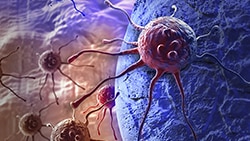Over the past few years the outcome for cancer patients has become much more positive, thanks to new and novel therapeutics that are being developed.

One promising new approach involves drugs that rally the body's own immune system to fight the disease. These so-called "immunotherapeutic drugs" are based on monoclonal antibodies (mAbs), large and complex molecules engineered in living cells.(1)
Agilent provides a portfolio of products that work together seamlessly to advance new immunotherapeutic drug candidate research from conception to reality. Agilent technology solutions include:
- 1260 Bio-Inert & 1290 Infinity UHPLCs
- TOF & Q-TOF mass spectrometers
- Spectroscopy solutions
- Capillary electrophoresis solutions
- Laboratory Informatics software
- BioConfirm software
- AssayMAP Bravo protein sample preparation
- A broad portfolio of biocolumns
Current cancer research is advancing with new, targeted therapeutics called "antibody-drug conjugates" (ADCs) that contain both a mAb and a cytotoxin bound together. The mAb imitates the body's immune system, causing it to bind to a target diseased cell. The cytotoxic agent then releases a lethal toxin into the cell.(2)

ADCs are extremely complex, and only a few providers around the world have the technical expertise to develop them. Agilent has recently partnered with MabPlex, the largest ADC producer in Asia, to establish a joint lab in Yantai, northeastern China.
Together, Agilent and MabPlex will provide an integrated analytical platform for researchers, offer analytical services, and support the sustainable development of China's biopharmaceutical research industry.
For Research Use Only. Not for use in diagnostic procedures.
References
(1) Scott AM, Allison JP, Wolchok JD. Monoclonal antibodies in cancer therapy. Cancer Immun. 2012;12:14.
(2) Alley SC, Okeley, NM, Senter, PD. Antibody-drug conjugates: Targeted drug delivery for cancer. Curr. Opin. Chem. Biol. 2010, 14, 529–537.
Find out more:
- Agilent Cancer Research
- Agilent Solutions for Biosimilars and Antibody-Drug Conjugates (PDF of PowerPoint presentation)
- Agilent Cooperates with MabPlex to Establish a Joint Laboratory for Advanced Biopharmaceutical Research and ADC Analysis Platform (Chinese)
- Agilent Liquid Chromatography
- Agilent Mass Spectrometry
- Agilent Molecular Spectroscopy
- Agilent Capillary Electrophoresis & CE/MS
- Agilent Software & Informatics
- Agilent BioConfirm Software
- Agilent AssayMAP Bravo Sample Preparation
- Agilent AdvanceBio Columns